There are dozens of stinkhorn species in North America, all of which are stinky, bizarre, and bring up A LOT of questions. Chances are you’ve encountered one or two of these weird fungi along trails or in your garden. Many questions result from the shock of this outlandish “thing” suddenly growing in the yard, landscape mulch, or field. Stinkhorns love to pop up overnight, wow everyone with their design and atrocious smell, and then disappear as quickly as they arrived.
This guide isn’t going to cover all the stinkhorns in North America but will highlight some of the more common. We’ll also talk about eating stinkhorns – that’s right, some of these species are edible!

Jump to:
All About Stinkhorns
Stinkhorns are among the most asked-about fungi because they’re totally crazy looking, seem to appear overnight right in your garden or landscape mulch, and stink. Like, really, really stink. If you do run into one, please don’t pick it. Not because it’s dangerous but because you’ll spend days trying to scrub that foul smell off your hands.
All stinkhorn fungi belong to the Phallaceae family. Within this family, the stinkhorns occupy many genera. There are a lot of stinkhorns! As of a 2008 estimate, there are approximately 77 stinkhorn species across 21 genera.
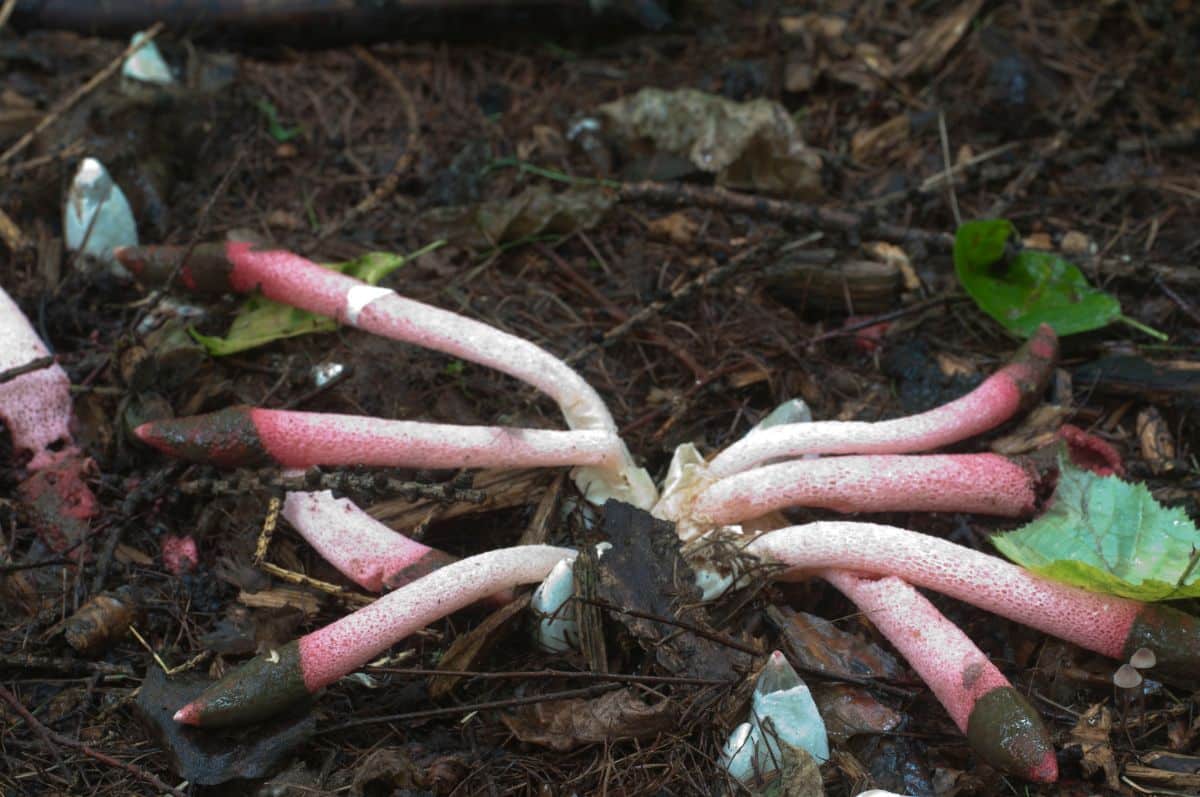
The species within the stinkhorn genera all share two main commonalities:
- At some stage during the fungus’ development, a part of the fruiting body is covered in a stinky, repellent slime.
- The fruiting body of the fungus emerges from an “egg.”
Once you get beyond these standard features, the world of stinkhorns is incredibly diverse, wild, and even straight-up out-of-sci-fi-movie wacky. And, usually, quite disturbing. Who needs sci-fi when you have stinkhorns bursting out of the ground to terrify you??

Just a few stinkhorn shapes:
- Dog penises (of many shapes, colors, and styles)
- People penises (of many shapes, colors, and styles)
- Octopus tentacles
- Crab claws
- Chinese lanterns
- Whiffle balls
- Sea anemones
Stinkhorns are saprophytes, which means they feed on decaying organic matter. They especially like mulch, and that’s why they’re so common in gardens, yards, and among landscaped areas.

Stinkhorn Life Cycle
The basics of stinkhorn anatomy start with an egg. When the stinkhorn first forms above ground, it is shaped like an egg. This oval fruiting body is gelatinous and either fully buried or partially buried in the ground. Quite often, you have to dig for it.
The egg’s outer layer (the peridium) is composed of 2-3 layers. The outermost layer is a thin, elastic membrane. The next layer is fleshy, thick, and gelatinous. In the center of the egg is the stinkhorn embryo form, which is the beginning of the mushroom body formation.

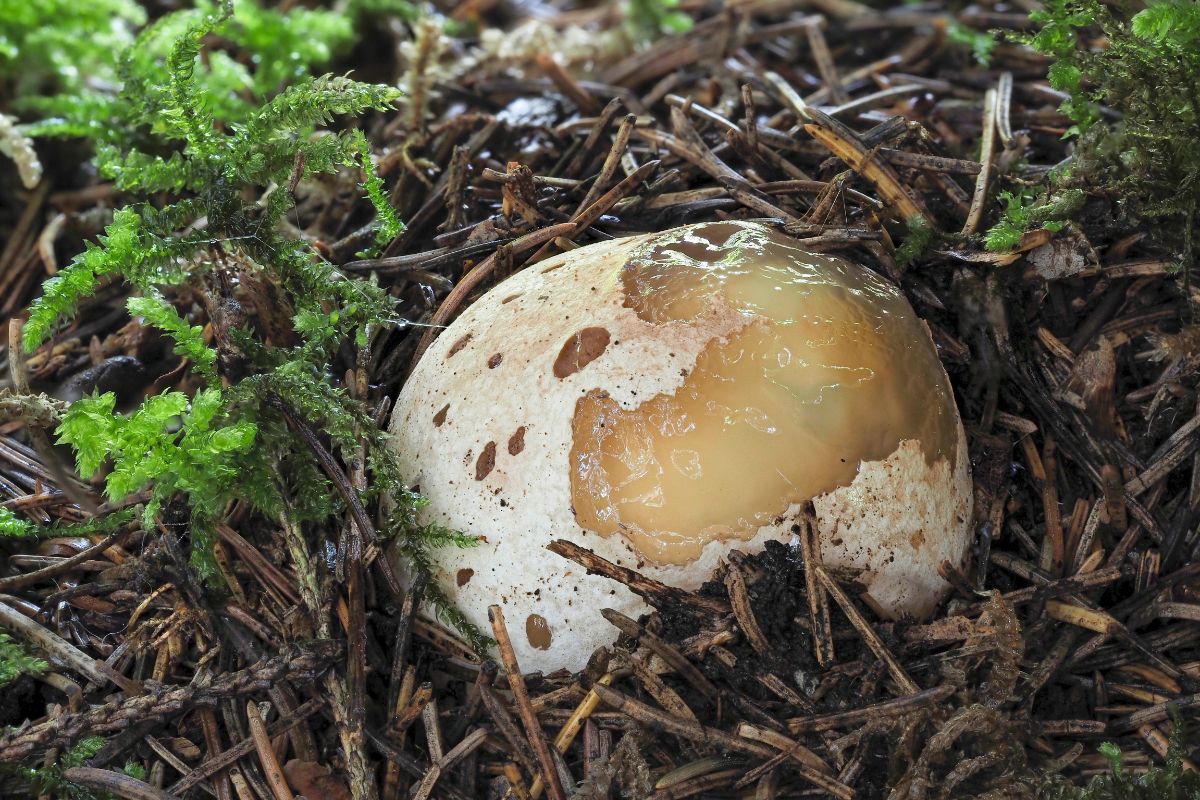
When you cut the egg in half, the outer layers are apparent, but the stinkhorn embryo is often super faint, depending on the age of the egg. As the fungus matures, the mushroom form becomes more apparent inside the egg. You might see the outline of a cap forming or a short stem.
As the fruiting body grows, it busts out of the egg. The egg may remain as a volva at the base of the stem. Or, many times, evidence of the egg beginning is lost in the growth process.

When the fungus is ready to release spores, it produces a very, very (very!) horrible-smelling slime. Their perfume is reminiscent of decomposing flesh or dung. This slime attracts flies, beetles, and other stink-loving insects. These bugs land on the stinkhorn and happily eat up the slime. As they’re perched there feasting, their feet are also immersed in the slimy goop. Once they’ve had their fill, the insects fly away, spreading spores from their feet and digestive tracts. And so, the stinkhorn continues its life cycle.
There are many stinkhorns native to North America, but also a few that are introduced. Stinkhorn spores love to travel, and some have traveled across oceans and continents, along with the spread of mulch, trees, soil, and sod.


Are Stinkhorns Dangerous to People, Pets, or Plants?
No. To all of these. Stinkhorns are not poisonous, dangerous, or otherwise problematic. Yes, they may look freaky, but they aren’t going to harm you, your pets, or your yard. Just let them be; they’ll disappear quickly enough.
You can try to get rid of them if they really bother you, but picking them isn’t going to do it. All fungi emerge from mycelium deep in the ground. You’d have to dig up your yard or garden to prevent them from appearing again. So, you can destroy the yard by attempting to remove the mycelium or let them live their short, stinky lives and move on.
The only danger these happily phallic-shaped fungi pose is potentially to your innocence or delicate sensibilities.

Stinkhorn Mushroom Identification
Due to the unique and unusual appearance of so many species in this family, there is no overarching way to identify a stinkhorn. However, upon investigation, all stinkhorn species share two characteristics.
- The egg-like appearance of the immature body. The eggs are often white but can also be other colors. They look very much like puffballs in this stage.
- All stinkhorn species produce spore slime to attract insects. An extremely repulsive smell usually accompanies this. Common adjectives used to describe the smell include foul, disgusting, offensive, rotting meat, and like a sewer. The intensity of the smell varies between species, but it is almost always exceedingly strong and very noticeable (much to the smellers’ dismay).

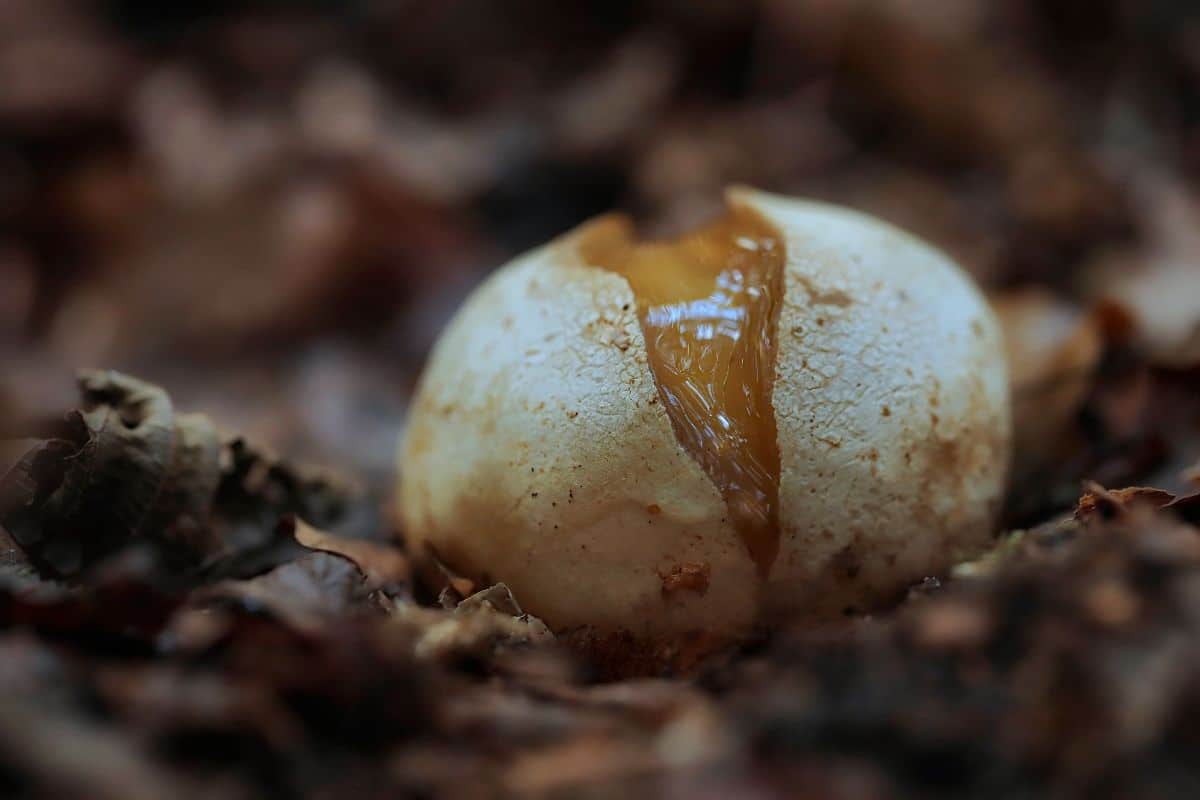
North American Stinkhorns
Mutinus
The Mutinus stinkhorns are among the most widespread. And, generally, they’re easy to identify because they look like a penis. Most people akin their likeness to a dog penis, which is pretty accurate. It’s pretty bizarre just how much they resemble a penis — I think Mother Nature must have a sense of humor.
Mutinus caninus (literally, dog penis) is the type species of this group. It frequently appears in North American mushroom guides and sources, but, as is so common (and if you’ve read anything on this website, it comes up A LOT), this turns out to be a specifically European species. M. caninus does not occur in North America, or, at least, not naturally.
Elegant Stinkhorn (Mutinus elegans)
Also known as dog stinkhorn, headless stinkhorn, and my personal favorite, the devil’s dipstick(!).
- Region: Widespread in eastern North America, from the east coast, Midwest, Florida, and Hawaii
- Season: Summer and fall
- Habitat: Cultivated areas like gardens and landscapes, also found in the woods.
- Description: The egg form is white or purplish. The mature body is penis-shaped with a tapered point. The stalk is bright orange or pink to start but then fades to a lighter orange or pinkish color. Stalks are hollow, spongy, and wrinkled in youth, then become lightly pock-marked. When it is new and fresh, the top third of the tip is covered with olive-brown slime.
- Size: Stalk is 2.5-7 inches long and around 1/2″ thick.
- Notes: Grows singularly or in large, overlapping groups that make it look like one giant mushroom instead of dozens of singular specimens clustered together. It is at its smelliest when the slime is on the tip. With age, the slime (spore dispersal method) disappears.

Ravenel’s Red Stinkhorn (Mutinus ravenelii)
- Region: Widespread across North America, specifically in the Appalachian mountains, northern states, and PNW.
- Season: Summer through fall
- Habitat: Cultivated areas like gardens and landscapes, also found in the woods.
- Description: The egg form is white or yellowish. A mature stinkhorn is phallic with a tapered point. The stalk is pink or red, then fades to pale pink. The stalks are hollow, spongy, and lightly pocked. When it is fresh, the top of the tip is covered in brown spore slime.
- Size: Stalk is 1.5-3.5 inches long and 1/2” thick
- Notes: Often confused with the elegant stinkhorn, but Ravenel’s is much brighter red or pink. It is also more compact in stature – much shorter at maturity than the Elegant stinkhorn.


Phallus
As you might be able to guess from the genus name, this group of stinkhorns are phallic (penis)-shaped. The Phallus species differentiates itself from other phallic-like stinkhorns with its rather spectacularly accurate shape. There is always a long, upright, evenly cylindrical stalk with a bell-shaped cap on top. And, to top it off (literally), is a round open upraised circle at the very top of the cap, which is where the cap meets the stem. It looks like lips pursed to whistle or exude something gross.
Some of the species in this group even get a little fancy, producing a lacy net-like growth around their stalk.
Common Stinkhorn (Phallus impudicus)
Impudicus is from the Latin for immodest or shameless. This stinkhorn is an especially fast grower, sometimes growing at a rate of 4-6 inches per hour. It exerts enough force to push through asphalt!
- Region: Widespread across North America but more common west of the Mississippi.
- Season: Summer through fall
- Habitat: Cultivated areas like gardens and landscapes, mulched areas, rotting wood, and meadows.
- Description: Immature egg form is white or purplish, with the base attached to the underground mycelium through white or purple rhizomorphic threads. The mature body features a white finely pocked stem and a whitish cap covered in brown spore slime. The cap has a reticulated pattern, with the white cap pattern showing through the slime. Common stinkhorn stems are hollow and spongy, and the cap clearly sits on top.
- Size: Stem is 2.75-4.25 inches tall and .75-1.25 inches thick. Cap is 1-2.25 inches tall.
- Notes: The odor of this species is powerful and bad. The common stinkhorn is often confused with yellow morels. Once insects have taken all the spore slime off the top of the stinkhorn, it looks like a yellowish, pitted cap, much like a morel. Add in the hollow stem, and it is easy to see how this can happen. The volva at the base of the stinkhorn, the smell, and the slime residue is usually enough to tell the species apart.


Netted Stinkhorn (Phallus duplicatus)
- Region: East of the Rocky Mountains
- Season: Summer and fall
- Habitat: Gardens, cultivated areas, mulch, meadows, lawns, and hardwood forests.
- Description: The immature egg is whitish or pinkish, and the base is attached to the underground mycelium through white or purple rhizomorphic threads. The stem of this species is white, hollow, and pock-marked. Caps of this species clearly sit atop the stem and are white to cream-colored with a delicate reticulated, pocked pattern.
The cap is covered with a thick, dark brown spore slime. Usually, you can see the cap reticulation through the slime, but sometimes it is so thick the cap looks smooth. The pits and ridges are apparent when the slime is no longer there. Below the rim of the cap, a white net forms and extends halfway down the stem. It flares out slightly to look like a skirt or petticoat. - Size: The stem is 3-5.5 inches tall and .75-1.25 inches thick. The cap is 1-2 inches tall.
- Notes: The netted stinkhorn is easily differentiated from other species due to the ornate white netted skirt. It is the only species in the United States with this feature.
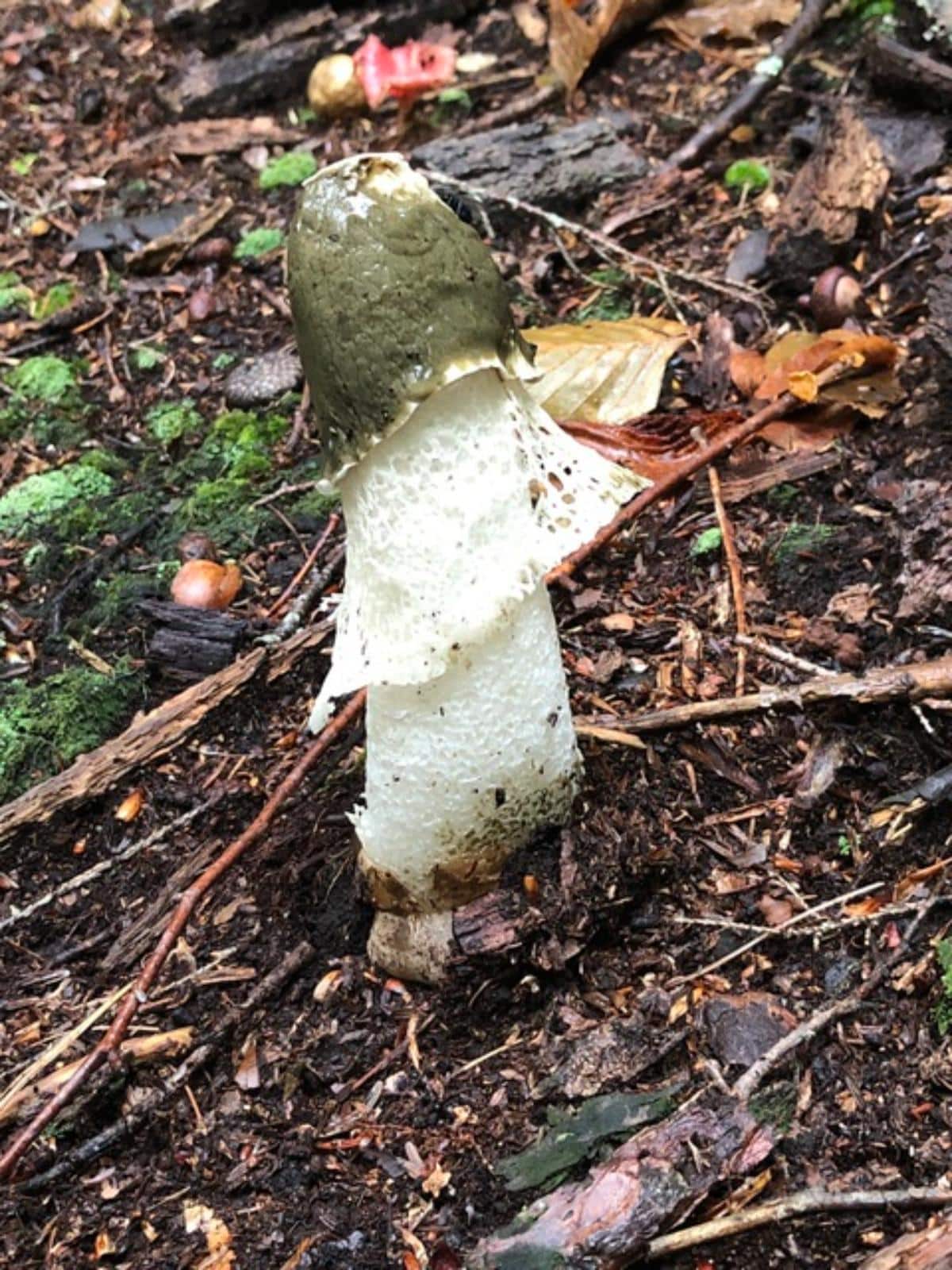
Phallus rugulosus
- Region: Widespread, more common in the Midwest and Mid-Atlantic states (northern United States)
- Season: Spring through fall
- Habitat: Cultivated areas, urban locations, gardens, mulch, lawns, and on woodchips.
- Description: The immature egg is white or slightly purple and attached to the mycelium underground through white thread-like rhizomorphs. Mature specimens feature a red to reddish-orange stem and a cap that is clearly separate from the stem. The stem is slightly tapered at the top, pock-marked, hollow, and fades to pinkish-orange with age. Caps are cone-shaped and red when young, then fade to orange. They are either finely wrinkled or smooth and covered in dark brown spore slime.
- Size: The stem is 3-4.75 inches long and .25-.60 inches wide. The cap is .50-1 inch tall.
- Notes: This species is commonly confused with Mutinis elegans due to its stalk color. However, there is a clear difference – P. rugulosus cap is separate from the stem, while Mutinus elegans doesn’t have a cap.

Phallus rubicundus
This species looks extremely similar to P. rugulosus, described above. It is challenging to know the exact range of this species since it is often confused. It is thought to be a southern and southwestern species, while P. rugulosus is primarily a northern species.
Phallus rubicundus has a lighter-colored stem that is more pinkish-red to pink, not usually bright reddish-orange like P. rugulosus. The stem is often slightly swollen in the center. It fades to light orange.

Ravenel’s Stinkhorn (Phallus ravenelii)
- Region: Widespread across North America, but more common in the east
- Season: Fall, possibly winter in warmer locales
- Habitat: Cultivated areas, urban locations, gardens, mulch, lawns, woodchips, and in the woods. Loves rotting wood.
- Description: Immature egg form is white, purplish, or pinkish and is attached to the mycelium underground through white thread-like rhizomorphs. This is a tall stinkhorn with a slightly tapered white to light yellow stem. The stem is hollow, spongy, and pock-marked. Caps on Ravenel’s are cone-shaped, creamy white to dull gray, and slightly wrinkled or smooth. The cap is clearly separated from the stem and covered with dark brown spore slime.
- Size: Stem is 4-7 inches tall and .75-1.25 inches wide. The cap is 1-2 inches tall.
- Notes: This stinkhorn is relatively easy to tell apart from other Phallus species due to its smooth cap surface. Other species feature reticulated or pitted and ridged surfaces.


Aseroe
There are only a few species in this group, of which only one occurs in North America.
Anemone Stinkhorn (Aseroe rubra)
This is a fantastically weird-looking stinkhorn species. It looks like a red sea creature with many tentacles stretching out. It is also commonly known as the starfish fungus and sea anemone fungus.
- Region: Southeastern United States and Hawaii
- Season: Year-round
- Habitat: Woody debris and decaying plant material, cultivated areas, gardens, in compost, and in the woods.
- Description: The immature egg form is tan or brownish and is attached to the mycelium underground through thread-like rhizomorphs. As it bursts from the egg, it looks like a light pink funnel with fingers clenched in a fist. The lower funnel portion is the stem, which has fine horizontal lines and is hollow. The stem portion can also be red, orange, or white. As it grows further, the body stretches outwards to display the brilliant reddish-pink coloring of the fingers or tentacles. At full maturity, the top part is flattened with 5-7 1.5 inch tentacles radiating outward. The tentacles are doubled, arranged symmetrically, and covered with olive-brown spore slime. Tentacles can also be white, orange, or pink.
- Size: The body grows up to 3.25 inches tall.
- Notes: Nothing else in North America looks like this alien fungus!
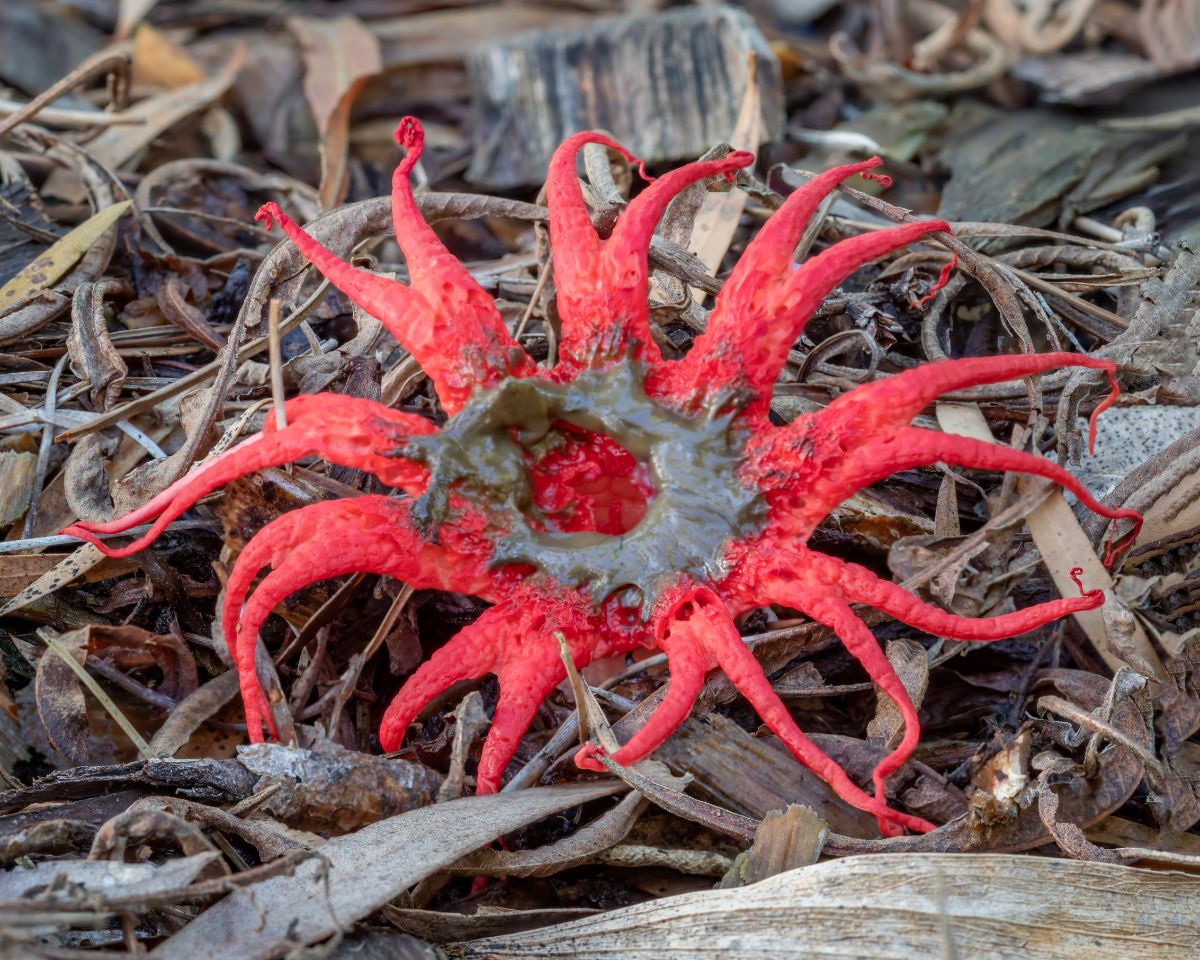

Lysurus
This stinkhorn species is known for its short, chunky arm-like bodies that reach up from the ground like claws. There are 19 species in this family, with three appearing in North America. Most of them are found in tropical areas.
Lantern Stinkhorn (Lysurus mokusin)
Also known as ribbed lizard claw and small lizard’s claw.
- Region: Widespread but scattered appearances. It is most common in California.
- Season: Summer or year-round, depending on the climate
- Habitat: Urban habitats and disturbed lands, like gardens, lawns, mulched areas, and meadows.
- Description: The fungus starts out as a whitish-colored egg. When it emerges, it has a thick, dense pinkish-red or slightly orange stem. The stem is thick ribbed or fluted, with 4-6 vertical spines and concave surfaces in-between. Vertically aligned pock marks cover the entire stem. The stem is also hollow and spongy soft. At the top of the stem is a head formed by the extended vertical ribs. These extensions, or arms, start out fused together with the tips joined together. It resembles a person with their fingertips pressed together and pointed upwards. Or a crab claw. If you are Italian, you may find this very familiar. The inner surface of the clasped fingers or claw is covered in dark brown spore slime in youth. As the fungus ages, the spore slime dissipates to reveal orange underneath. The fingertips may separate with age, too.
- Size: Stem is 3-6 inches long and .25-.1 inches thick. Head is .25-.75 inches tall.
- Notes: This stinkhorn may be an introduced species in North America. It is native to Asia.

Lizard’s Claw Stinkhorn (Lysurus cruciatus)
- Region: Widespread but scattered appearances.
- Season: Summer or year-round, depending on the climate
- Habitat: Urban habitats and disturbed lands, like gardens, lawns, mulched areas, and meadows.
- Description: The fungus starts out as a whitish-colored egg. When it emerges, it has a thick, dense pale orange or whitish stem. The stem is rounded and dense and is covered in pock-marks. The stem is also hollow and spongy soft. At the top of the stem is a head made up of 4-7 short extensions called arms or fingers. These extensions, or arms, are dark or pale orange and start out fused together with the tips joined. It resembles a person with their fingertips pressed together and pointed upwards. Or a crab claw. With maturity, the fingers separate and stretch outwards. Each arm is covered in accordion-like folds, is hollow, and is pointed at the tops. They also have a vertical seam on the outer edge, which opens up with age. The interior surface of the fingers or claw is covered in dark brown spore slime in youth.
- Size: The entire body is 1.5-3.25 inches tall.
- Notes:

Stalked Lattice Stinkhorn (Lysurus “periphragmoides”)
Also known as the chambered stinkhorn.
This species is all jumbled up. The scientific name in the quotations above has been used widely and for decades to describe this pinky-orange basket-topped fungus. However, a 2018 DNA analysis clearly puts that scientific name with a yellowish or white-stalked species from Asia and Africa. This leaves the orange type without a name or precise definition. For now, the commonly assigned name is in parenthesis, but we expect that to change sometime in the near future.
- Region: Widespread
- Season: Summer or year-round, depending on the climate
- Habitat: Urban habitats and disturbed lands, like gardens, lawns, mulched areas, and meadows. It also grows in open woods and pastures.
- Description: The fungus starts out as a whitish-colored egg. When it emerges, it has a thick, dense pale orange or pinkish-orange stem. The stem is rounded and dense and is covered in pock-marks. The stem is also hollow and spongy soft. At the top of the stem is a head like a latticed basket. Branches of the fungi interconnect to form a rounded net over the top of the stem. The branches are the same color as the stalk, orange to orange-red, and feature dense wrinkles and accordion-like folds. In the interior of the mesh basket is a stinky dark brown spore slime. The basket generally features 20-100 mesh holes which are hexagonal or pentagonal.
- Size: The stem is 2-6 inches tall and .25-.75 inches wide. The head is .75-1.20 inches wide.
- Notes:

Clathrus
When you see a fungus from the Clathrus genus, you’re not likely to forget it easily. These fungi are creepily alien-looking!
Octopus Stinkhorn, aka Devil’s Fingers (Clathrus archeri)
- Region: Northern California, but perhaps more widespread as it seems to spread easily
- Season: Summer or year-round if the climate is warm
- Habitat: Urban habitats and disturbed lands, like gardens, lawns, mulched areas, and meadows.
- Description: The immature egg body is whitish and spotted with pinkish-brown discoloring. When it emerges from the egg, 4-7 bright red octopus-like arms stretch out from a central point (pseudostem). At first, the arms are connected at the tips, but then they separate. The arms are tapered to points at the ends, densely pitted, hollow, and spongy. As they age, their color fades to pink. Very dark brown spore slime covers the inner surfaces of the arms, making it look like they are striped or drizzled with chocolate.
- Size: Body is 3-6.75 inches tall and 1-2 inches wide. The arms are 1-4.75 inches long.
- Notes: Scientists believe this species is endemic to Australia, New Zealand, and southern Africa. Everywhere else it occurs, including N. America, is as a naturalized invasive.


Column Stinkhorn (Clathrus columnatus)
- Region: Gulf Coast, Mid-Atlantic
- Season: Spring through fall or year-round if the climate is warm
- Habitat: Urban habitats and disturbed lands, like gardens, lawns, mulched areas, and meadows. Also likes woody debris, and sometimes grows on living trees or from stumps.
- Description: The immature egg body is whitish. When it emerges from the egg, 3-5 bright orange-red column-like arms stretch out from a central point but without a stem. The arms are separate but joined at the base. At first, the arms join at the tips but then unfold and extend out. They are equal in width (no tapered tips), densely pitted, hollow, and spongy. Their color fades to pink or light yellow as they age, and their arms may flatten. Brown spore slime covers the inner surfaces of the arms.
- Size: Columns reach 3 inches tall and 1-2 inches wide.
- Notes: This species is differentiated from Pseudocolus fusiformis by the lack of a stem and white eggs. The column stinkhorn may be an introduced species in North America, brought in with wood chip shipments.

Clathrus crispus
- Region: Gulf Coast, Florida
- Season: Year-round
- Habitat: Urban habitats and disturbed lands, like gardens, lawns, mulched areas, and meadows.
- Description: The immature egg body is whitish or light tan. When it emerges from the egg, it forms a rounded, latticed basket of arms. This lattice or mesh-like basket is bright red, and the holes are semi-evenly distributed and of similar size. Along the outer edge of each hole is a circle of grooved flesh, a “corona” surrounding it. When young, this corona is usually much darker colored. The meshed arms are densely pitted, hollow, and spongy. Their color fades to pink or light orange as they age, and their arms may elongate to the point they look like columns. Brown spore slime covers the inner surfaces of the arms.
- Size: The fruiting body averages 4-6 inches tall and 1.5-3.25 inches wide.
- Notes: A similar species, Clathrus ruber, appears in California. C. rubrer is wider and more orange. Most noticeably, it lacks the coronas around the mesh holes like C. crispus.


Pseudocolus
There are three species in this genus, with only one appearing in the United States.
Stinky Squid (Pseudocolus fusiformis)
- Region: Eastern North America
- Season: Spring through fall or year-round if the climate is warm
- Habitat: Urban habitats and disturbed lands, like gardens, lawns, mulched areas, and meadows. Also likes woody debris and sometimes grows on living trees or from stumps.
- Description: The immature egg body is whitish or light tan. When it emerges from the egg, 3-4 orange to pale orange column-like arms grow from a small central stem. The arms join at the tips and stay that way. They are tapered at the ends, densely pitted, hollow, and spongy. As they age, the arm color fades to light orange or white. The arms are concave on the outer side and convex on the inner side. Dark brown spore slime covers the inner surfaces of the arms.
- Size: Fruiting body averages 1.5- 2.75 inches tall.
- Notes: This species is differentiated from Clathrus crispa, which lacks a stem and has only white eggs. It is an introduced species in North America.

Itajahya
This genus contains three species, set apart from other stinkhorns by their tissue hats.
Itajahya galericulata
- Region: Southwestern United States, including Texas
- Season: Summer and fall
- Habitat: Urban habitats and disturbed lands, like gardens, lawns, mulched areas, and meadows.
- Description: The fungus starts out as a whitish-colored egg. When it emerges, it has a thick, dense white to yellowish stem. The stem is rounded, covered in pock-marks, hollow, and spongy soft. At the top of the stem is a brown bell-shaped head. The head is made up of tons of wrinkled tissue, which gives it a granular appearance. On top of the head is a circular white cap –a patch of tissue that is wider than the width of the head. The brownness of the head is actually a covering of spore slime.
- Size: The stinkhorn is 3.5-4.75 inches tall and 1-1.75 inches thick.
- Notes: Due to its odd worldwide distribution, it is thought this is an introduced species.

Gallery of Stinkhorn Mushrooms Around The World

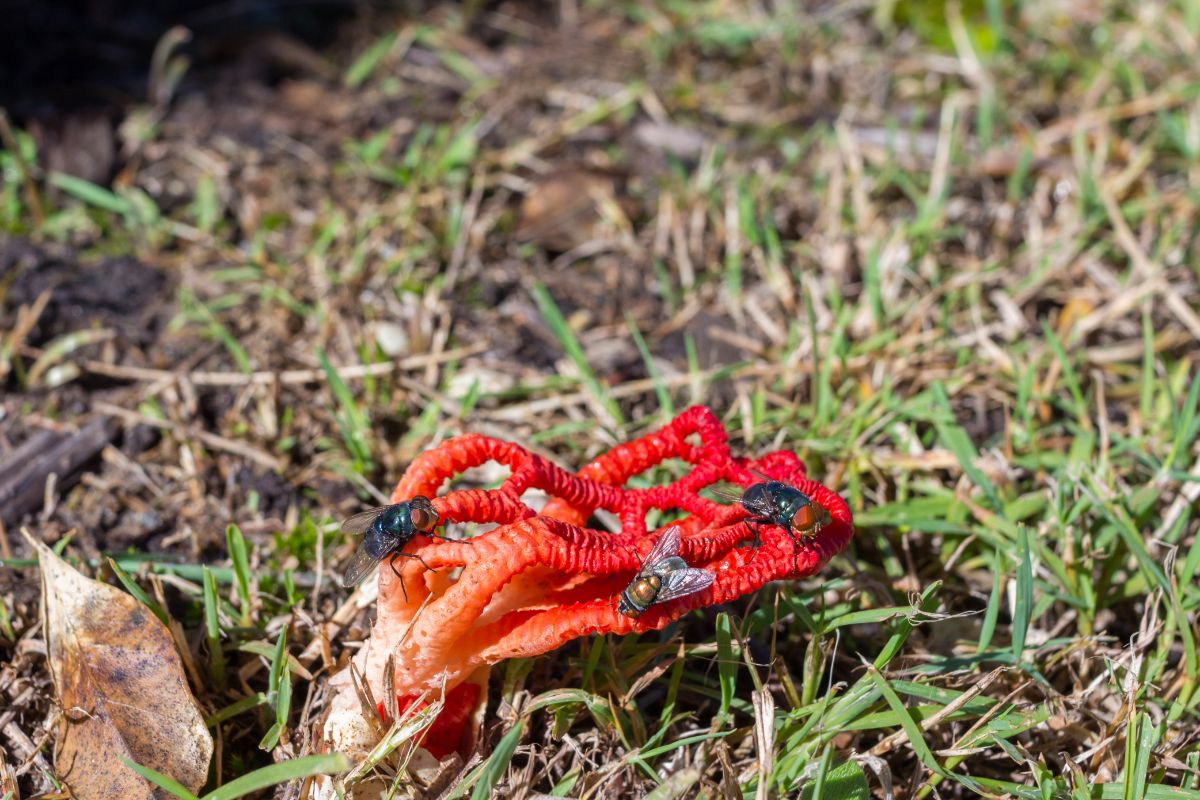
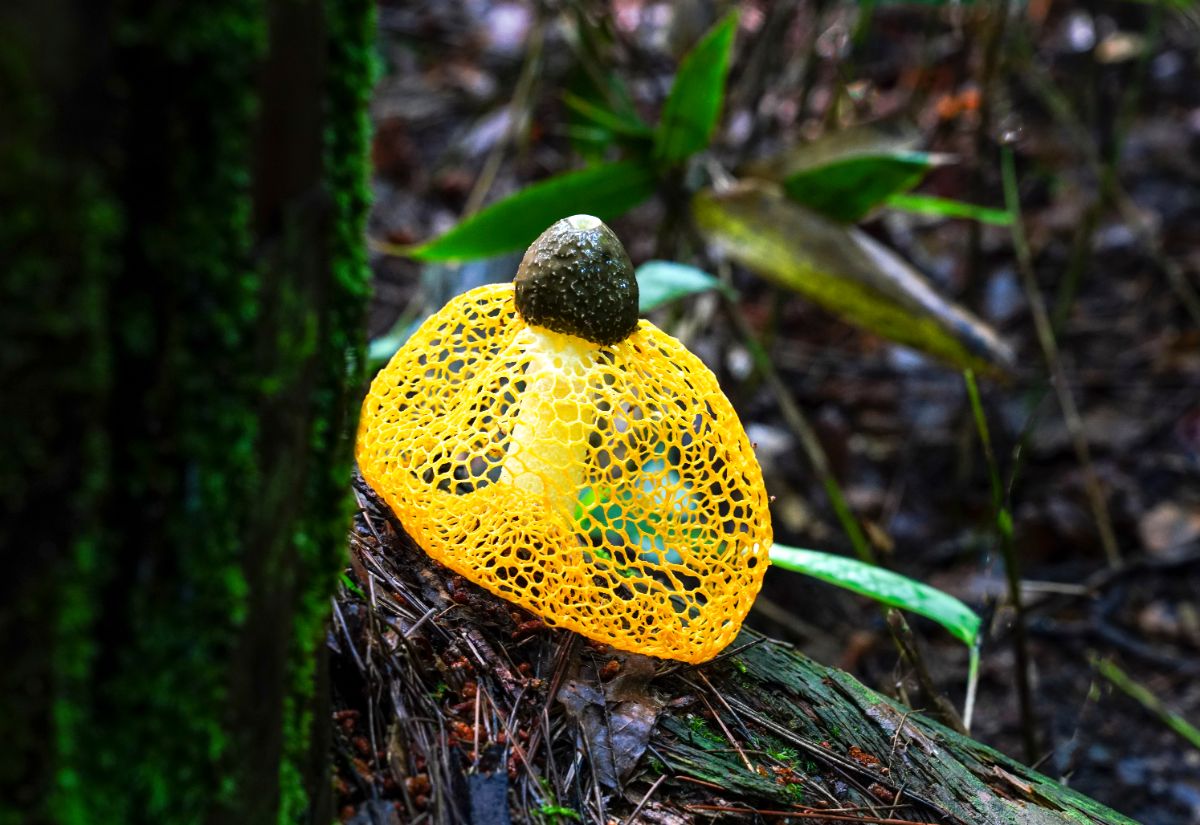






Interested in learning about other bizarre fungi species? Check out our guides to:
Common Questions About Stinkhorn Mushrooms
Are stinkhorns edible?
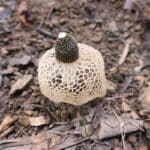
Due to the overpowering offensive smell, most people don’t think about eating them. However, they are eaten as a delicacy in many countries.
The immature egg form is said to be a bit crunchy and reminiscent of radishes. At this stage, they don’t smell like death. The taste and smell vary widely by species; some taste muskier, while others taste rather plain or pleasant.
Mature basket stinkhorns (Phallus indusiatus) are a delicacy in Asia. There, they are known as bamboo mushrooms and are thought to be an aphrodisiac.
The cooked stinkhorn body is said to be tender, fresh, and fragrant. Bamboo mushrooms are commonly found in Asian markets as dried stalks; the smelly caps are removed during harvesting. Preparation includes rehydrating them, and then they are used in stir-fries and soups.
There is no definitive guide (that this researcher could find) about whether ALL stinkhorn species are edible. So, to be safe, you should absolutely identify the species first before eating them.









Tonja Huxtable says
Awesome article! Really helped me identify, and I wish I’d read it before I uprooted all the growths in my yard. Thanks for this, I’ll leave the rest I find- Cheers!- Tonja
Jenny says
Glad it helped! Honesty, they’re probably show up again next year unless you got rid of the underground mycelium 😀
Renee C says
Jenny, thank you so much for much for this detailed article and excellent photos! Despite being a lifelong gardener (in Northern California) I had not encountered one of these fungi until today, when I found my dog shredding one (a Clathrus Rubra, I believe). I didn’t know if he had eaten any or if they were toxic. Finding your article online saved me a trip to the vet! I’m very grateful.
Jenny says
Glad it helped! Wonder what your dog’s attraction to it was… liking the stinky things lol!